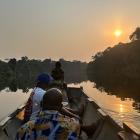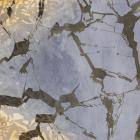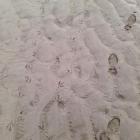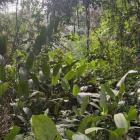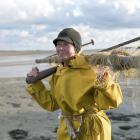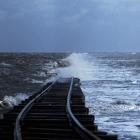Flows
The temporal flows of Morecambe Bay, shaped by its shifting tides and impermanent landscapes, have long influenced the practices of those who depend on its waters. For Steve Brown, a lifelong fisherman from Fleetwood, the Bay is not a fixed entity, but a fluid environment constantly evolving. Over the years, Steve has observed dramatic changes in the Bay, with sandbanks migrating unpredictably, old fishing grounds vanishing, and new ones emerging almost overnight. The geography of the coastline is rewritten by tides, storms, and human intervention. Morecambe Bay has always been in flux, but, as Steve observes, the pace of change seems to be accelerating.
As Steve puts it, fishing in Morecambe Bay is not just about technique but about attunement and agency—an ability to listen to the land and the water. He recalls how a single storm, one “dark and stormy night,” caused the river to change course entirely, carving through the land in a way no engineering could prevent. The illusion of permanence is just that. Roads, docks, and flood defenses may try to fix the landscape, but the tides continue to tell their own stories, rewriting the coast as they have for thousands of years. The water, Steve suggests, keeps its own memory. Old marshes reveal where tides once reached. Silting patterns trace the histories of lost channels. Even the ghost of a glacial tunnel—the “Lune Deep”—has been gradually filling in over decades, restricting the drainage capacity of Morecambe Bay. To fish these waters is to work within that memory, responding to a past that is not buried but alive, still shaping the present.
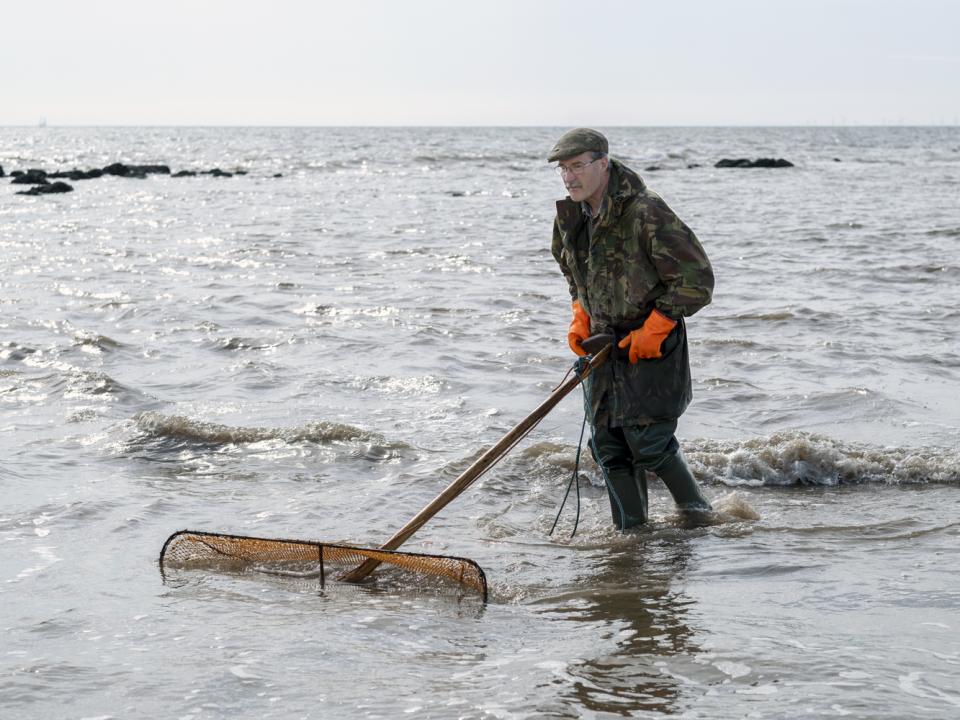
Figure 16: Steve Brown shrimping using a push net, Fleetwood, Lancashire, 2019. Photograph from the series “Going to the Sand” by Tessa Bunney.
Figure 16: Steve Brown shrimping using a push net, Fleetwood, Lancashire, 2019. Photograph from the series “Going to the Sand” by Tessa Bunney.
© 2019 Tessa Bunney. Used by permission.
The copyright holder reserves, or holds for their own use, all the rights provided by copyright law, such as distribution, performance, and creation of derivative works.
The Bay’s rhythms are not only hydrological or geological but also biological. The movements of fish, the spawning of shrimp, the growth of mussel beds—all unfold in rhythms tied to moonlight, temperature, and salinity. Steve’s practice depends on sensing these subtle cues, much like how his predecessors did before him. Knowledge passed down orally, through gesture and story, forms a kind of living calendar: seasonal migrations, breeding tides, the arrival of jellyfish warning of salt changes. It is a biological clock tied not to hours, but to cycles—many of which are now being disrupted by climate shifts. For Steve, fishing is a form of navigation through time. It is about reading the Bay’s moods, remembering where the channels ran last year, and imagining where they might be tomorrow. His knowledge, gained through lived experience rather than textbooks, is an archive of the wetland’s past and a guide to its uncertain future.
Similarly, Margaret and Trevor Owen, two longtime fisherfolk from Overton, have developed a deep attunement to the temporal flows of Morecambe Bay over the years. Margaret, who began her fishing life walking the sands of Sunderland Point as a child, reflects on the intimate relationship between human practices and the rhythms of the Bay’s natural cycles. Growing up in a place cut off by the tide twice daily, Margaret learned to read the changing landscape, developing an intricate understanding of the Bay’s rhythms. As she describes it, the shifting sands, tides, and the ebb and flow of water were not just markers of time but key elements of the ecological patterns that shaped her fishing practices. In this dynamic environment, Margaret and Trevor have honed their skills to move with the rhythms of the land, constantly attuning their activities to the subtle shifts in the environment, whether it be the turning of the tide or the patterns of marine life that follow the flow of the water.
Margaret’s practice of haaf net fishing—a traditional method involving wading into the river with an eighteen-foot net—embodies a deep, intuitive relationship with the rhythms of Morecambe Bay, where success depends on reading the tides, anticipating the fish, and responding to the subtle signals of the land and water. From childhood, she honed this skill through hours spent walking the sands, learning how fish often wait for the tide to turn and how the most dangerous, surging moments can be the most fruitful. For Margaret, the Bay once offered a sense of freedom, where tides were read by sight and feel rather than tables, but coastal changes and human infrastructure have disrupted these natural cues, transforming once-thriving mudflats into uncertain terrain and forcing constant adaptation. Fishing, she says, is like farming—you must know when to plant, harvest, and let the land rest—requiring respect, patience, and a keen sensitivity to the interplay of elements like rain, turbulence, and the blend of salt and freshwater. Physical and ecological markers—like ancient fishing baulks revealed by storms or birds signaling the turn of the tide—remain etched in her memory, reflecting a lifetime of listening to the Bay’s evolving voice. Alongside Trevor, and like fellow fisherman Steve, Margaret has learned to move with the land’s cycles, treating fishing not as a static technique but as a living dialogue with the landscape, where every shift in tide or sand is part of an ancient, ever-changing rhythm.
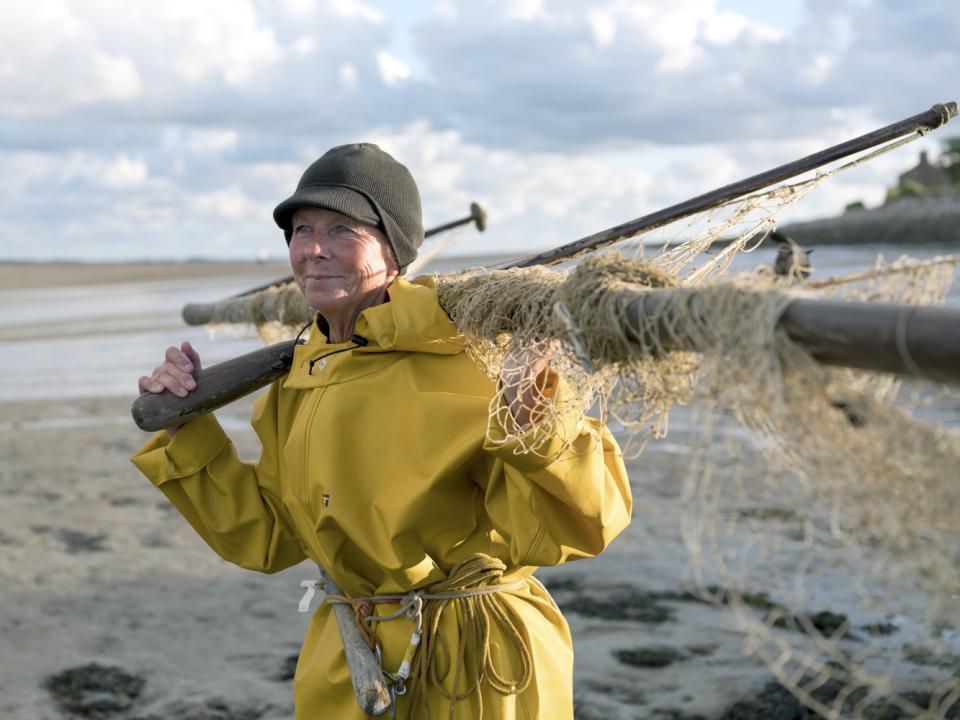
Figure 17: Margaret Owen with her haaf net, Sunderland Point, Lancashire, 2018. Photograph from the series “Going to the Sand” by Tessa Bunney.
Figure 17: Margaret Owen with her haaf net, Sunderland Point, Lancashire, 2018. Photograph from the series “Going to the Sand” by Tessa Bunney.
© 2018 Tessa Bunney. Used by permission.
The copyright holder reserves, or holds for their own use, all the rights provided by copyright law, such as distribution, performance, and creation of derivative works.
These stories of the fisherfolk reveal a deeper truth about Morecambe Bay: Time here does not follow a linear path but moves in cycles—cycles of water, sand, and human influence. The fishing practices of Steve, Margaret, and Trevor are shaped by this temporal flow, as they learn to read the ever-changing conditions of the Bay, responding to shifts in the environment with a deep knowledge of its rhythms. The unpredictability of the tides and the movement of the sands mean that fishing in Morecambe Bay is never static; it is a constant act of adaptation, one that requires an understanding of both the present moment and the historical patterns that shape the landscape.
In the Wadden Sea, time and landscape are uniquely intertwined through the rhythmic ebb and flow of tides and seasons, creating a temporal pattern that continuously shapes the physical environment. Unlike many other landscapes where change may be slower or less cyclical, here the daily tidal pulse reveals and conceals mudflats and pools in a dynamic cycle of exposure and submersion. This constant transformation sustains a hyperdynamic mosaic of habitats that support extraordinary biodiversity. The Tøndermarsken marshlands, part of the Wadden Sea National Park, exemplify this phenomenon—tidal flats that are renewed each day, providing rich feeding grounds for seals, fish, invertebrates, and especially birds. The region is a sanctuary for countless avian species, from resident oystercatchers and redshanks to seasonal migrants such as the curlew, dunlin, and grey plover. In spring and autumn, these migratory birds descend in vast numbers, transforming the marshes into a temporary haven teeming with motion and sound. Thousands of barnacle geese, elegant waders, and plovers fill the sky and fields, their calls echoing through the air as they move with the tides, creating a dynamic and ever-shifting landscape shaped by flight, feeding, and rest.
One of the most breathtaking seasonal spectacles in the Tøndermarsken is the “Black Sun” murmuration—a mesmerizing aerial ballet performed by thousands of starlings, sometimes as many as one hundred and fifty thousand, just before sunset in spring and autumn. From early March to mid-April and again from mid-August through October, these birds gather in massive flocks to roost in the reed beds of the marshes, their synchronized movements forming dark, shifting patterns in the sky—like a living language written in flight. This mesmerizing behavior serves as both protection and performance: Moving as one, the flock confuses predators such as sparrowhawks, merlins, hen and marsh harriers, northern goshawks, and even peregrine falcons. The reed beds offer ideal roosting grounds, sheltered from ground predators like foxes and out of reach of sight-dependent birds of prey once night falls. At the same time, the marsh meadows provide abundant food—beetle larvae that help the starlings fuel up for breeding in spring and prepare for migration in late summer. Yet this stunning spectacle—and the delicate ecosystem that sustains it—is increasingly under threat from an unlikely source: renewable energy, specifically the development of offshore wind farms. These developments risk disrupting the delicate balance of the Wadden Sea’s tidal and migratory rhythms through noise, visual interference, and changes to the marine environment. The very rhythms that enable phenomena like the Black Sun to occur may be destabilized, placing both wildlife and local communities in a precarious position. Like the fisherfolk of Morecambe Bay, who must constantly adapt to shifting tides, the people and creatures of the Wadden Sea now face the complex challenge of balancing progress with preservation—where the pursuit of sustainability in one form could inadvertently threaten another. In this rare and fluid meeting of land, sea, and sky, even nature’s grandest performances remain vulnerable to the far-reaching impacts of human ambition.
Figure 18: Murmuration in Tøndermarsken, 26 March 2025. Video by Enaiê Mairê Azambuja.
Just as the starlings of Tøndermarsken move in rhythm with the marshlands’ shifting seasons, so too do the lives of women in the village of Doum unfold in tune with the landscapes they inhabit—whether forest or roadside, cultivated field or village compound. For the women of Doum, time flows depend on the place. In our focus group—separated off from the men—we hear that life is split unevenly between the forest and the roadside, spending more time in the latter nowadays. In the village, the women take care of the household—cooking, cleaning, and looking after children, some of whom attend school. The women plan the “program of the week” as they put it, including church on Sundays. In the fields, the women sow plantain, macabo, cassava, maize, wild yams, and ground nuts.

Figure 19: Akom Village by the road, Dja-et-Lobo, South Region, Cameroon. Photograph by Blake Ewing, January 2025. Akom is a mixed Baka and Bantu village on the paved roadway from Mintom (Cameroon) towards Congo-Brazzaville.
Figure 19: Akom Village by the road, Dja-et-Lobo, South Region, Cameroon. Photograph by Blake Ewing, January 2025. Akom is a mixed Baka and Bantu village on the paved roadway from Mintom (Cameroon) towards Congo-Brazzaville.
© 2025 Blake Ewing. Used by permission.
The copyright holder reserves, or holds for their own use, all the rights provided by copyright law, such as distribution, performance, and creation of derivative works.
In the forest the women go fishing and collect food, such as mushrooms, while the men hunt. To fish, the women construct small dams. Time passes differently here. A woman explains that when they are in the forest, you do not need to look at the time because there are birds that tell you that we are already in such and such a time: Kouloukao, Kukoluo, Mango, Ouluka, Teni, Yoka. For instance, the Kukuluo orders from 6 a.m. to 6 p.m. Despite these durational markers, though, time flows more quickly in the forest. In the bush they are always busy, without waiting for things to cook or children to arrive home from school.
But while it is hard to allocate more time in the forest, fishing and collecting is becoming difficult. The wetlands and streams are changing due to climate change. Collecting non–timber products is also less predictable since plants are flowering at different times and sometimes they need to wait for leaves to clear. There is also a scarcity of certain medicinal plants, especially the moabi tree, prized by the state and logging companies for its timber. Later in the afternoon we walk by a group of women returning from a few hours of fishing. They are very frustrated. What used to be enough time to produce a bucket full of fish has only rendered five or so. “The stream is too dry.”
In wetlands, time is not measured by clocks or calendars, but by the rhythmic pulse of tide, land, and season. These landscapes are alive with motion—shaped not only by natural forces but by human hands, histories, and hopes. For the fisherfolk of Morecambe Bay and the migratory flocks of the Wadden Sea, survival depends on attuning to these temporal flows, reading the signs of change, and responding with adaptability and care. Whether through the intimate knowledge of shifting sandbanks, the collective dance of starlings at dusk, or the lives of the Doum women, these places reveal a profound truth: Life at the edge of land and water is shaped by cycles that are both repetitive and rhythmically reliable, yet always nuanced by variability and change. In this fluid world, past, present, and future are intertwined—not as fixed points in a simple loop, but as overlapping layers of experience that inform one another. To live in harmony with these landscapes is to recognize their cyclical patterns while embracing their constant transformation and unpredictability.
Keywords: impermanence
Link words: memory, history, rhythms, archives, tradition, cycles, adaptation, seasons, conservation, progress






